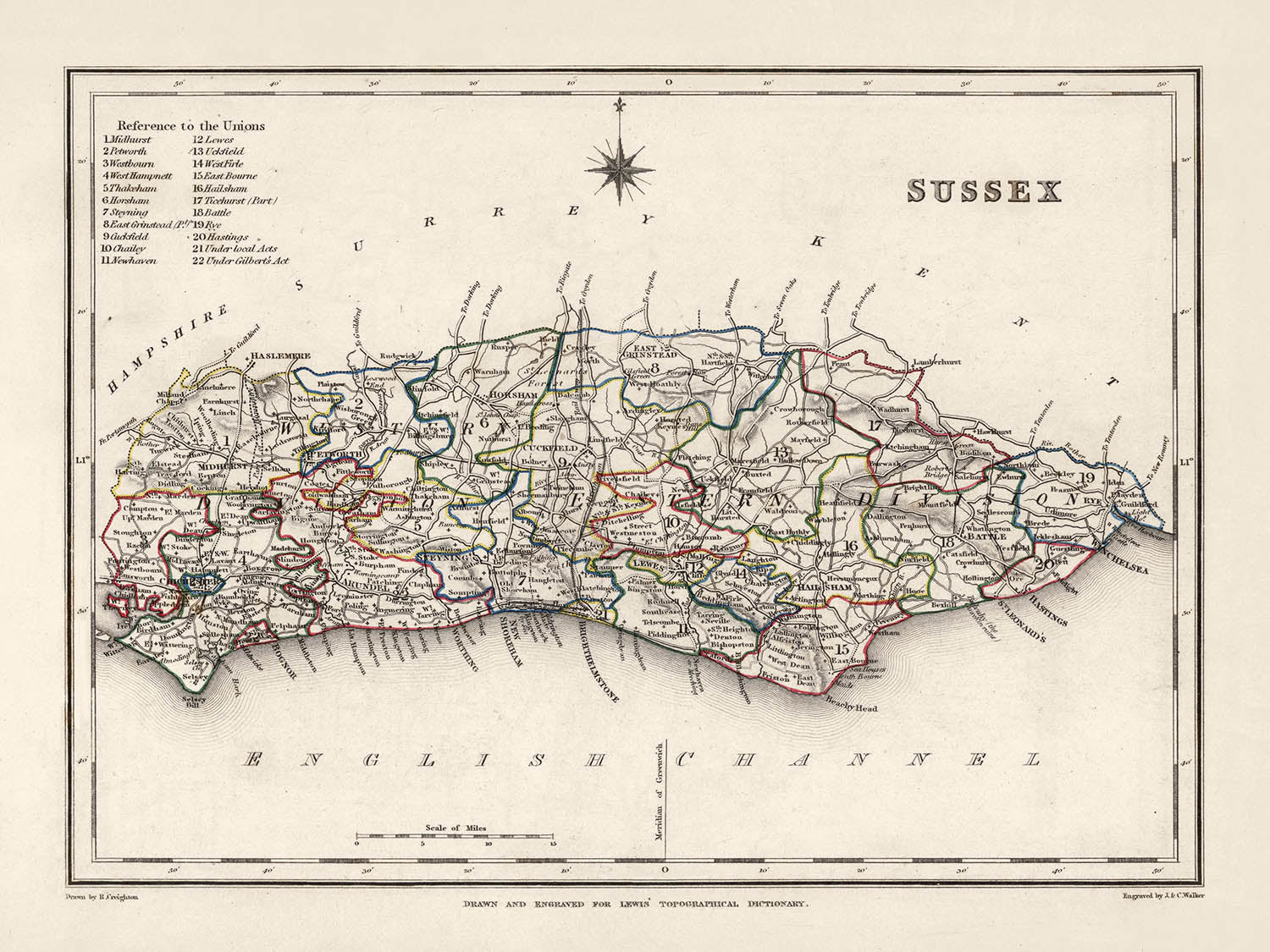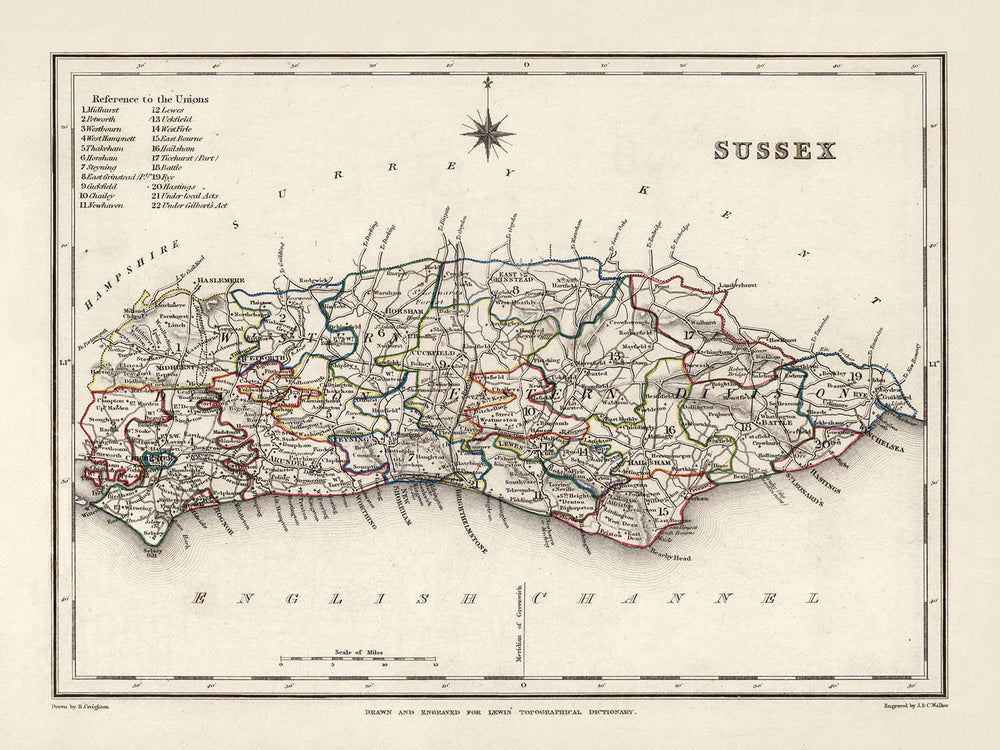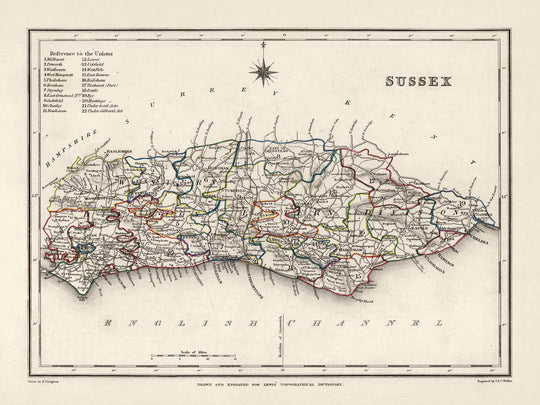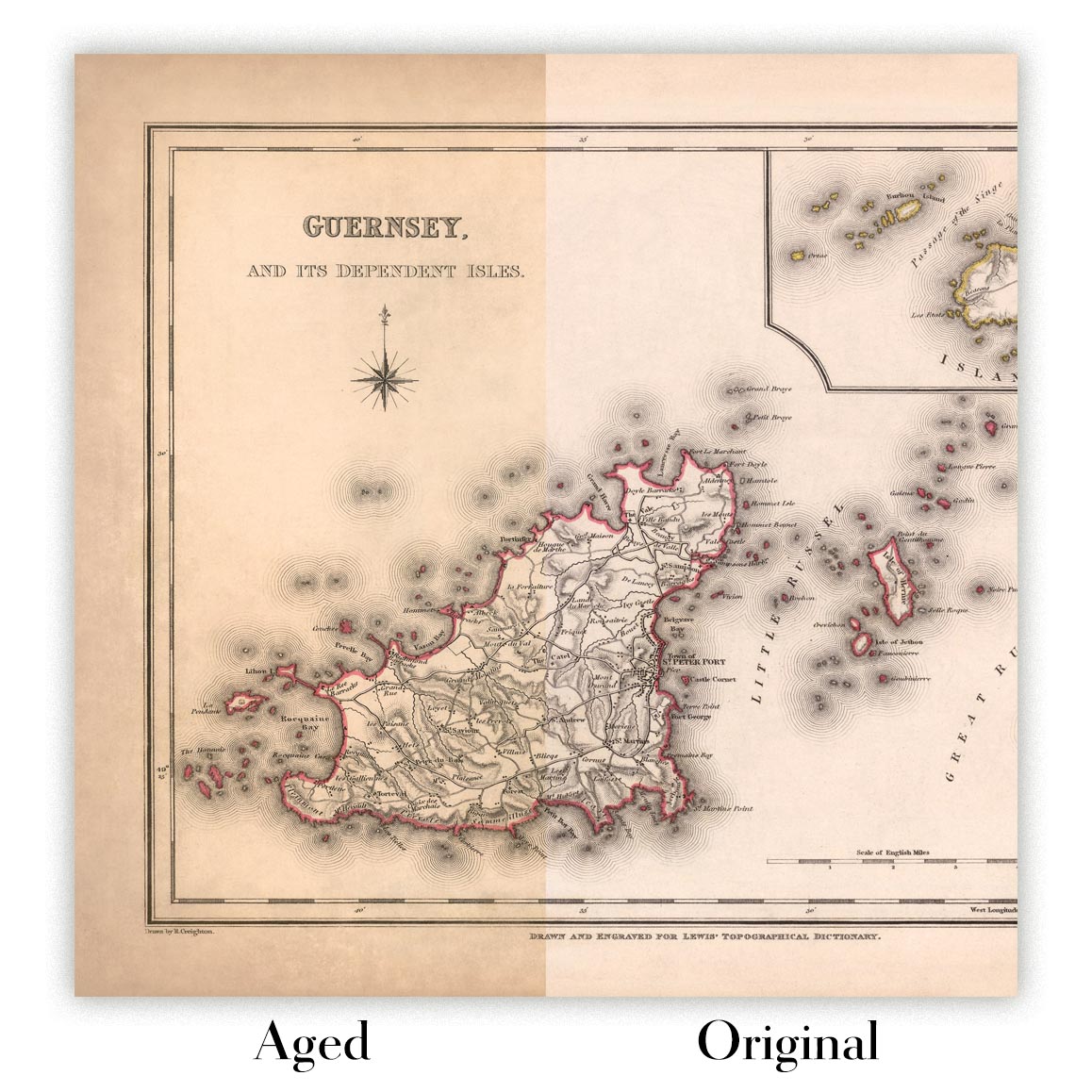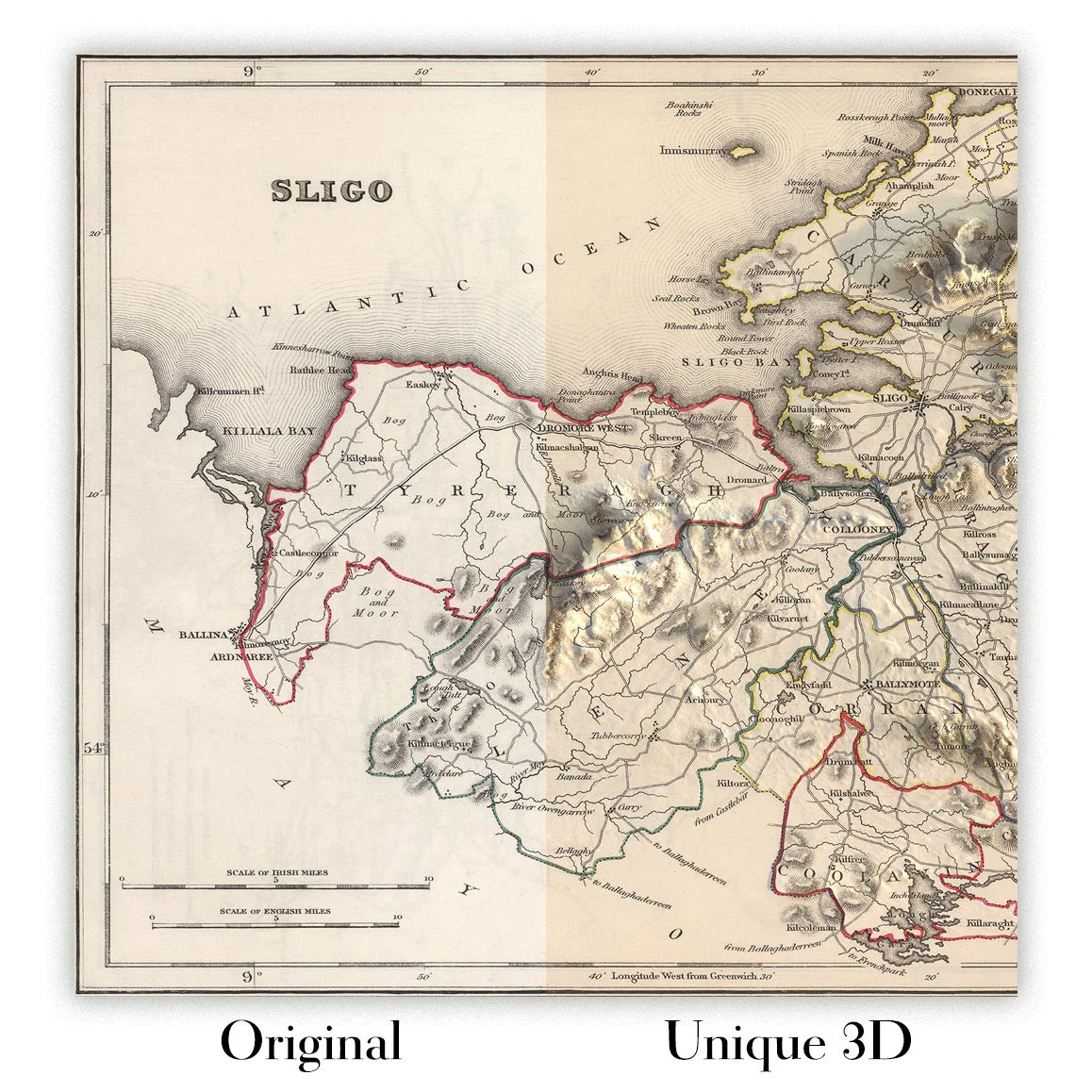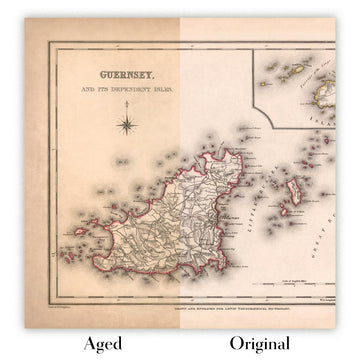- Handmade locally. No import duty or tax
- FREE Delivery by Christmas
- Love it or your money back (90 days)
- Questions? WhatsApp me any time
Own a piece of history
5,000+ 5 star reviews


Immerse yourself in history with this remarkable 1844 map of the historical county of Sussex, created by the renowned cartographer Samuel Lewis. This finely detailed representation of East and West Sussex, elegantly reflects the geographical, architectural, and socio-cultural facets of the region during the mid-19th century. As a work of historical and artistic significance, this map embodies the charm and mystique of an era characterized by profound transformation and discovery.
What makes this map so unique is its ability to transport the viewer back to a time when some of today's most populous cities were either non-existent or known by different names. While many well-known locations such as Brighton, Crawley, and Worthing are clearly identifiable, some modern settlements may be absent or delightfully appear under earlier names. This aspect enhances the allure of the map, making it not only a fascinating item of antiquity but also a treasure trove for history enthusiasts, cartography aficionados, and all those who appreciate the rich and diverse heritage of Sussex.
Settlements:
- Brighton (Founded before 1086): Known as a vibrant seaside town, Brighton, recorded in the Domesday Book, is well known for its cultural, artistic, and tourism attractions such as the Brighton Pier and the Royal Pavilion.
- Crawley (Founded around 1202): Originally a small market town, Crawley is now a large town and borough in West Sussex, famous for its proximity to Gatwick Airport.
- Worthing (Founded in 1803): A large seaside town, Worthing was a small fishing hamlet until the late 18th century.
- Eastbourne (Founded before 1086): A resort town on the south coast, Eastbourne is known for its Victorian hotels, the 19th-century Eastbourne Pier, and a 19th-century fort.
- Hastings (Founded around 8th century): Known for the famous 1066 Battle of Hastings, it is a fishing port with a beach-based fishing fleet.
- Bexhill (Founded in 772): Known for the De La Warr Pavilion, a major UK center for contemporary art.
- Chichester (Founded in 43 AD): Known for the well-preserved Roman walls and the Chichester Cathedral.
- Hove (Founded before 1086): Known for the flamboyant architecture of buildings like the Hove Museum and Art Gallery.
- Lewes (Founded in 6th century): Known for Lewes Castle and the annual Guy Fawkes Night celebrations.
- Horsham (Founded before 947): Known for Horsham Park and the Causeway, a street of 16th-century houses.
- Littlehampton (Founded before 1086): Known for its award-winning sandy beach.
- Burgess Hill (Founded around 1700s): Known for its Victorian architecture and Ditchling Common Country Park.
- Haywards Heath (Founded in early 19th century): Known for Borde Hill Garden, a sprawling area of parkland and woodland.
- Uckfield (Founded in 1220): Known for the Bridge Cottage, a 15th-century Wealden hall house.
- Shoreham-by-Sea (Founded before 1086): Known for its bustling port and Shoreham Airport, the oldest in the UK.
- Southwick (Founded before 1086): Known for Southwick Green, a large open space that's been a market area since the 13th century.
- Peacehaven (Founded in 1916): Known for its stunning chalk cliffs and the Greenwich Meridian Line.
- Bognor Regis (Founded in 1785): Known for its clean beaches, and Hotham Park.
- East Grinstead (Founded before 1066): Known for its architectural conservation area with buildings from the 14th to the 18th century.
- Midhurst (Founded in 7th century): Known for the Cowdray ruins and the South Downs National Park.
- Polegate (Founded in 13th century): Known for its close proximity to the Pevensey Levels and Cuckoo Trail.
- Seaford (Founded in 1086): Known for the Seaford Museum of local history.
- Selsey (Founded before 5th century): Known for its Selsey Lifeboat Station.
- Crowborough (Founded in 14th century): Known for the Crowborough Cross, a well-known local landmark.
- Rye (Founded in 11th century): Known for its medieval, half-timbered houses and Rye Castle.
- Newhaven (Founded in 19th century): Known for the Newhaven Fort, a Palmerston fort built in the 19th century.
- Steyning (Founded in 1086): Known for its narrow, cobbled streets, and timber-framed buildings.
- Ringmer (Founded in 1086): Known for the Ringmer Stream and village green.
- Petworth (Founded before 1086): Known for Petworth House, an elegant mansion set in a beautiful deer park.
- Arundel (Founded in 1067): Known for Arundel Castle, the ancestral home of the Duke of Norfolk, and Arundel Cathedral.
Notable Natural Phenomena and Tourist Attractions:
- South Downs National Park: This stunning national park spreads across a large area of Sussex, offering picturesque landscapes, rolling hills, and chalk cliffs.
- The Seven Sisters: A series of chalk cliffs by the English Channel. They form part of the South Downs in East Sussex, between the towns of Seaford and Eastbourne.
- Ashdown Forest: Located in the High Weald Area of Outstanding Natural Beauty, it is famously known as the setting of the Winnie-the-Pooh stories.
- River Ouse: This river runs through the county and is a favorite for boating and riverside walks.
- Devil's Dyke: The largest dry valley in the UK, located in the South Downs. It offers panoramic views of the area and has a rich history.
Please double check the images to make sure that a specific town or place is shown on this map. You can also get in touch and ask us to check the map for you.
This map looks great at all sizes: 8x10in (20.5x25.5cm), 12x16in (30.5x41cm), 18x24in (45.5x61cm), 16x20in (40.5x51cm), 24x36in (61x91.5cm), 30x40in (76x101.5cm) and 37x50in (94x127cm), but it looks even better when printed large.
I can create beautiful, large prints of this map up to 50in (127cm). Please get in touch if you're looking for larger, customised or different framing options.
The model in the listing images is holding the 18x24in (45.5x61cm) version of this map.
The fifth listing image shows an example of my map personalisation service.
If you’re looking for something slightly different, check out my main collection of UK and Ireland maps.
Please contact me to check if a certain location, landmark or feature is shown on this map.
This would make a wonderful birthday, Christmas, Father's Day, work leaving, anniversary or housewarming gift for someone from the areas covered by this map.
This map is available as a giclée print on acid free archival matte paper, or you can buy it framed. The frame is a nice, simple black frame that suits most aesthetics. Please get in touch if you'd like a different frame colour or material. My frames are glazed with super-clear museum-grade acrylic (perspex/acrylite), which is significantly less reflective than glass, safer, and will always arrive in perfect condition.
This map is also available as a float framed canvas, sometimes known as a shadow gap framed canvas or canvas floater. The map is printed on artist's cotton canvas and then stretched over a handmade box frame. We then "float" the canvas inside a wooden frame, which is available in a range of colours (black, dark brown, oak, antique gold and white). This is a wonderful way to present a map without glazing in front. See some examples of float framed canvas maps and explore the differences between my different finishes.
For something truly unique, this map is also available in "Unique 3D", our trademarked process that dramatically transforms the map so that it has a wonderful sense of depth. We combine the original map with detailed topography and elevation data, so that mountains and the terrain really "pop". For more info and examples of 3D maps, check my Unique 3D page.
For most orders, delivery time is about 3 working days. Personalised and customised products take longer, as I have to do the personalisation and send it to you for approval, which usually takes 1 or 2 days.
Please note that very large framed orders usually take longer to make and deliver.
If you need your order to arrive by a certain date, please contact me before you order so that we can find the best way of making sure you get your order in time.
I print and frame maps and artwork in 23 countries around the world. This means your order will be made locally, which cuts down on delivery time and ensures that it won't be damaged during delivery. You'll never pay customs or import duty, and we'll put less CO2 into the air.
All of my maps and art prints are well packaged and sent in a rugged tube if unframed, or surrounded by foam if framed.
I try to send out all orders within 1 or 2 days of receiving your order, though some products (like face masks, mugs and tote bags) can take longer to make.
If you select Express Delivery at checkout your order we will prioritise your order and send it out by 1-day courier (Fedex, DHL, UPS, Parcelforce).
Next Day delivery is also available in some countries (US, UK, Singapore, UAE) but please try to order early in the day so that we can get it sent out on time.
My standard frame is a gallery style black ash hardwood frame. It is simple and quite modern looking. My standard frame is around 20mm (0.8in) wide.
I use super-clear acrylic (perspex/acrylite) for the frame glass. It's lighter and safer than glass - and it looks better, as the reflectivity is lower.
Six standard frame colours are available for free (black, dark brown, dark grey, oak, white and antique gold). Custom framing and mounting/matting is available if you're looking for something else.
Most maps, art and illustrations are also available as a framed canvas. We use matte (not shiny) cotton canvas, stretch it over a sustainably sourced box wood frame, and then 'float' the piece within a wood frame. The end result is quite beautiful, and there's no glazing to get in the way.
All frames are provided "ready to hang", with either a string or brackets on the back. Very large frames will have heavy duty hanging plates and/or a mounting baton. If you have any questions, please get in touch.
See some examples of my framed maps and framed canvas maps.
Alternatively, I can also supply old maps and artwork on canvas, foam board, cotton rag and other materials.
If you want to frame your map or artwork yourself, please read my size guide first.
My maps are extremely high quality reproductions of original maps.
I source original, rare maps from libraries, auction houses and private collections around the world, restore them at my London workshop, and then use specialist giclée inks and printers to create beautiful maps that look even better than the original.
My maps are printed on acid-free archival matte (not glossy) paper that feels very high quality and almost like card. In technical terms the paper weight/thickness is 10mil/200gsm. It's perfect for framing.
I print with Epson ultrachrome giclée UV fade resistant pigment inks - some of the best inks you can find.
I can also make maps on canvas, cotton rag and other exotic materials.
Learn more about The Unique Maps Co.
Map personalisation
If you're looking for the perfect anniversary or housewarming gift, I can personalise your map to make it truly unique. For example, I can add a short message, or highlight an important location, or add your family's coat of arms.
The options are almost infinite. Please see my map personalisation page for some wonderful examples of what's possible.
To order a personalised map, select "personalise your map" before adding it to your basket.
Get in touch if you're looking for more complex customisations and personalisations.
Map ageing
I have been asked hundreds of times over the years by customers if they could buy a map that looks even older.
Well, now you can, by selecting Aged before you add a map to your basket.
All the product photos you see on this page show the map in its Original form. This is what the map looks like today.
If you select Aged, I will age your map by hand, using a special and unique process developed through years of studying old maps, talking to researchers to understand the chemistry of aging paper, and of course... lots of practice!
If you're unsure, stick to the Original colour of the map. If you want something a bit darker and older looking, go for Aged.
If you are not happy with your order for any reason, contact me and I'll get it fixed ASAP, free of charge. Please see my returns and refund policy for more information.
I am very confident you will like your restored map or art print. I have been doing this since 1984. I'm a 5-star Etsy seller. I have sold tens of thousands of maps and art prints and have over 5,000 real 5-star reviews. My work has been featured in interior design magazines, on the BBC, and on the walls of dozens of 5-star hotels.
I use a unique process to restore maps and artwork that is massively time consuming and labour intensive. Hunting down the original maps and illustrations can take months. I use state of the art and eye-wateringly expensive technology to scan and restore them. As a result, I guarantee my maps and art prints are a cut above the rest. I stand by my products and will always make sure you're 100% happy with what you receive.
Almost all of my maps and art prints look amazing at large sizes (200cm, 6.5ft+) and I can frame and deliver them to you as well, via special oversized courier. Contact me to discuss your specific needs.
Or try searching for something!







